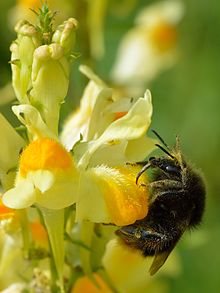Linaria
| Linaria | |
|---|---|
 |
|
| Common toadflax (Linaria vulgaris) | |
| Scientific classification | |
| Kingdom: | Plantae |
| (unranked): | Angiosperms |
| (unranked): | Eudicots |
| (unranked): | Asterids |
| Order: | Lamiales |
| Family: | Plantaginaceae |
| Tribe: | Antirrhineae |
| Genus: |
Linaria Mill. |
| Species | |
|
see text |
|
see text
Linaria is a genus of 150 species of herbaceous annuals and perennials and the largest genus in the Antirrhineae tribe of the plantain family Plantaginaceae.
Linaria was traditionally placed in the figwort family Scrophulariaceae. Phylogenetic analysis has now placed it in the vastly expanded family Plantaginaceae.
Closely related genera include the Nuttallanthus (American toadflaxes, recently split from Linaria), Antirrhinum (snapdragons) and Cymbalaria (ivy-leaved toadflaxes).
Some of the more familiar Linaria include:
The members of this genus are known in English as toadflax, a name shared with several related genera. The scientific name Linaria means "resembling linum" (flax), which the foliage of some species superficially resembles.
The genus is native to temperate regions of Europe, northern Africa and Asia, with the highest species diversity in the Mediterranean region.
Some Linaria are regarded as noxious weeds. They are likely toxic to , but ruminants generally avoid them.
Toadflaxes are used as food plants by the larvae of some Lepidoptera species, including the mouse moth (Amphipyra tragopoginis) and the common buckeye (Junonia coenia). L. vulgaris has been used as a medicinal herb for the treatment of many illnesses and conditions, including cancer, hepatitis, hemorrhoids, scrofula, and scurvy. It has been used as an astringent, an emollient and a laxative.
...
Wikipedia
